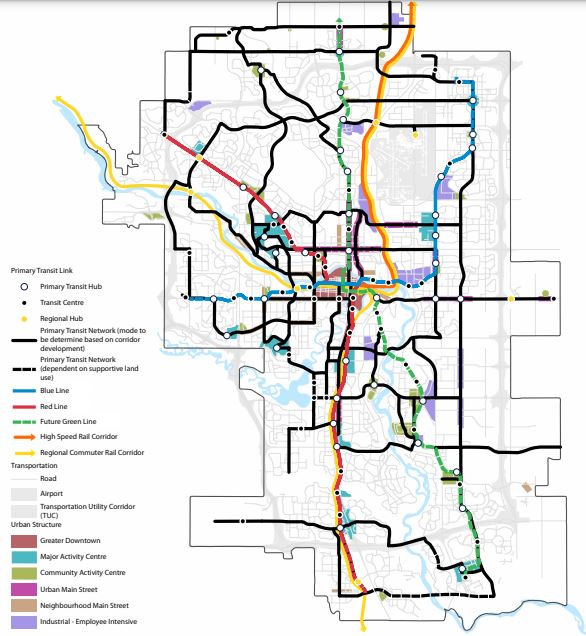An updated strategy to guide how Calgary Transit delivers its service over the next 30 years has cleared its first hurdle at City Hall, as transit officials change gears with a goal of to make the service more frequent.

Transit officials were at City Hall on Wednesday to deliver the updated strategic plan to the city’s infrastructure and planning committee.
Developed in 2012, ‘RouteAhead’ is a 30-year strategic plan that outlines operating and capital investments and improvements to riders’ experience on Calgary Transit.
As part of the 10-year updates, transit officials are looking to shift the focus to a more frequency-based service to bolster the creation of what’s called a primary transit network.
“The biggest thing that we’re trying to do is build the primary transit network, which really gives Calgarians that fast, frequent transit that runs early in the morning and late and night with buses and trains coming more often,” Calgary Transit planner Jordan Zukowski told Global News.

The frequency goals laid out in the updated plan are a bus or a train every 10 minutes, 15 hours per day and seven days per week on the primary transit network. This includes CTrains, Max Line buses, and buses along major routes.

Get daily National news
When it comes to local neighbourhood bus routes, the goal is every 30 minutes within the same time frame, with additional frequency when warranted.
However, transit officials note the change to a frequency-based network will require some route changes, and riders may have a longer walk to a bus stop, but most will have to travel less than five minutes to the stop.
That aspect of the updated strategy raised concerns with some city councillors who are anticipating some pushback from residents.
“There will be some pushback on some of those routes,” Ward 1 Coun. Sonya Sharp told reporters. “People are comfortable with these routes, and walking an extra ten minutes to a more frequent bus zone, as long as we can maintain that frequency, then we are doing what we set out to do.”
- Quebec man with history of involvement in human trafficking rearrested in Calgary
- Global’s Morning of Giving fundraiser returns in support of The Magic of Christmas
- RCMP in Brooks investigate anti-immigrant, white supremacist graffiti
- Calgary couple bear-sprayed, beaten after online transaction goes wrong
Transit officials told the committee that any route reviews, which would take place if the plan is implemented, would be data-driven.
“If there’s a bus stop that we see is very underutilized or not utilized at all, that’s maybe something that we would consider removing and that allows the bus to run a lot faster,” Zukowski said. “If we’re thinking of where are these bus stops that people are using a lot, where are they getting on a lot, those are key destinations that we want to keep people linked to.”
David Cooper, formerly a planner at Calgary Transit who now runs a consulting firm called Leading Mobility, said frequency based systems are used across the country and that it would with ridership on transit.
“Edmonton did this exercise in 2021 and their bus network has recovered 104 per cent of pre-pandemic ridership,” Cooper said. “We have a commuter-based service in pre-pandemic shape.”
Impacts from the pandemic continue to plague staffing at Calgary Transit, according to the Amalgamated Transit Union Local 583.
The union’s president Mike Mahar said a frequency-based service won’t be achievable until more operators and mechanics are hired on, with current staff stretched thin.
“Even if they’re working, eight or 10 hours, they’re in a uniform for over 14 hours,” Mahar told Global News. “When buses are running late, or they’re not showing up. It’s the transit operator that’s the first forward-facing employee, so they hear the brunt of it from the customers.”
Calgary Transit director Sharon Fleming said transit is working on hiring up to 800 employees this year to get back to pre-pandemic staffing levels, with a goal of hiring more if the updated RouteAhead plan is implemented.
The plan still needs to go to council for a final approval.
Pending that approval, Calgary Transit officials will bring forward an implementation plan with operating and capital costs and proposed route changes for a decision by council.
“It’ll be a journey,” Fleming said. “This is an investment over time and we need to catch up with our infrastructure, our buses, our hiring, to go along with that frequency increase.”






Comments